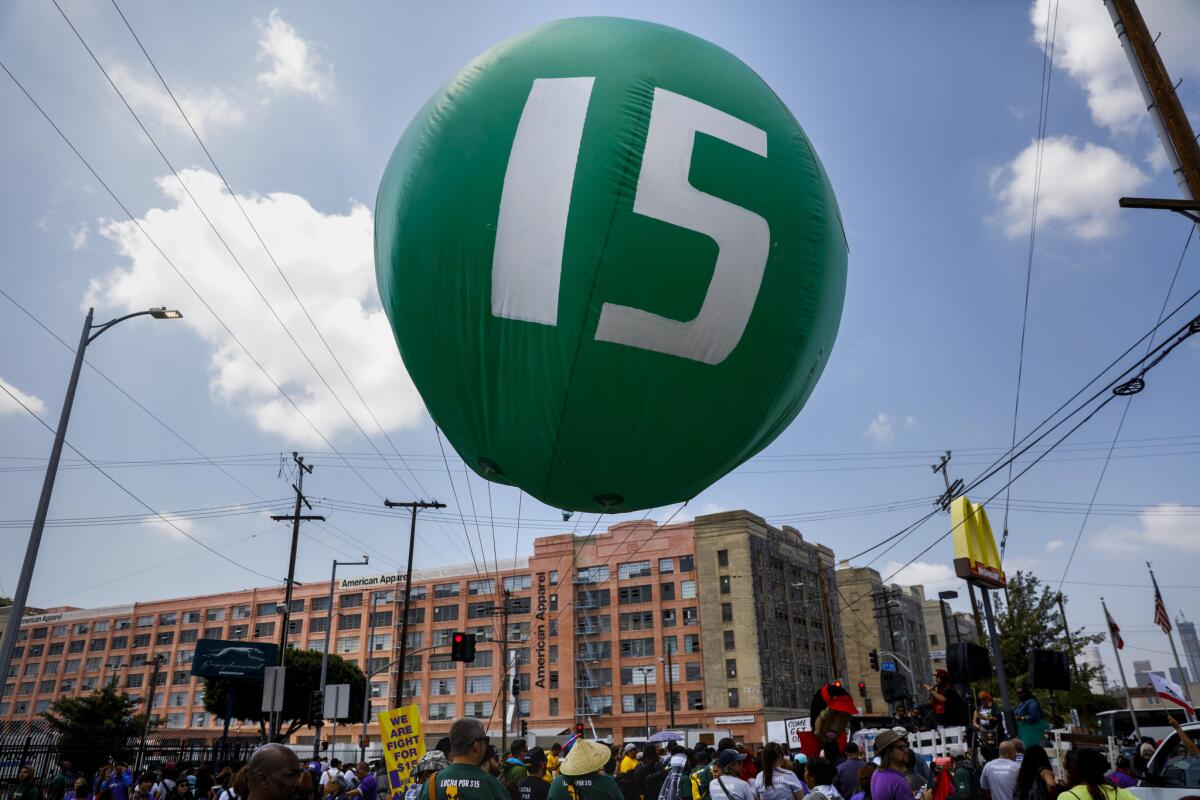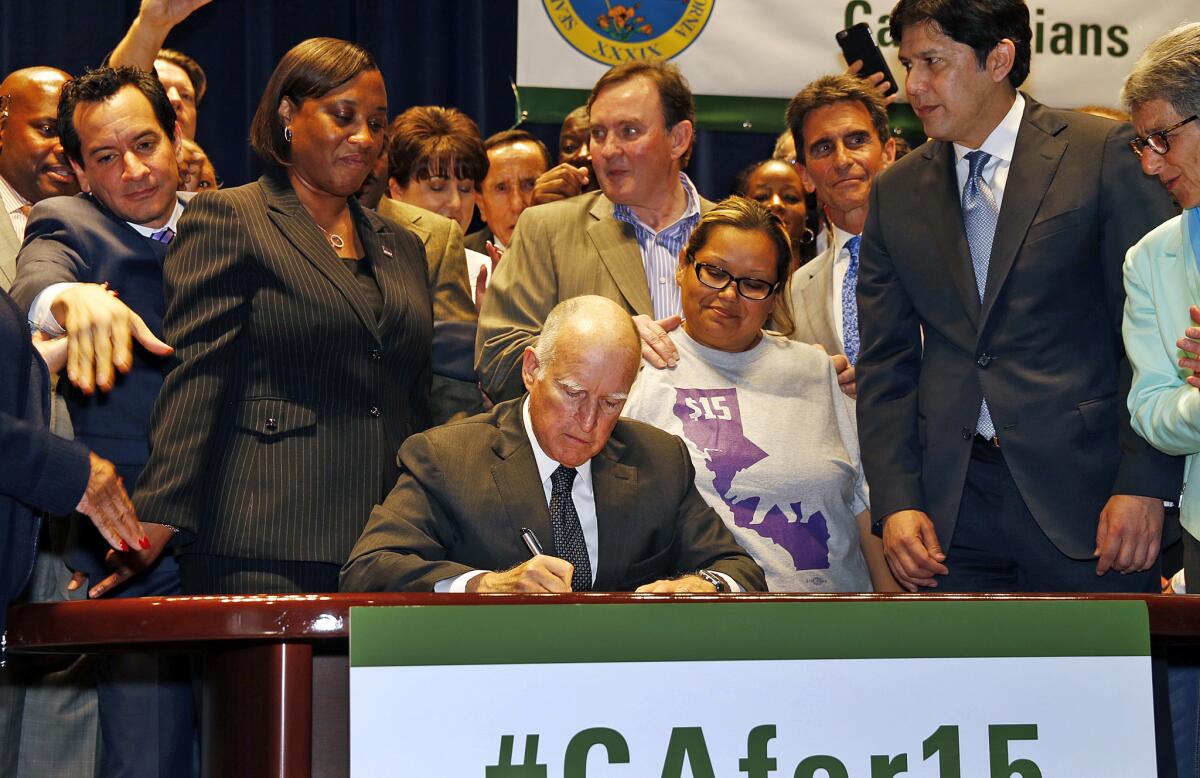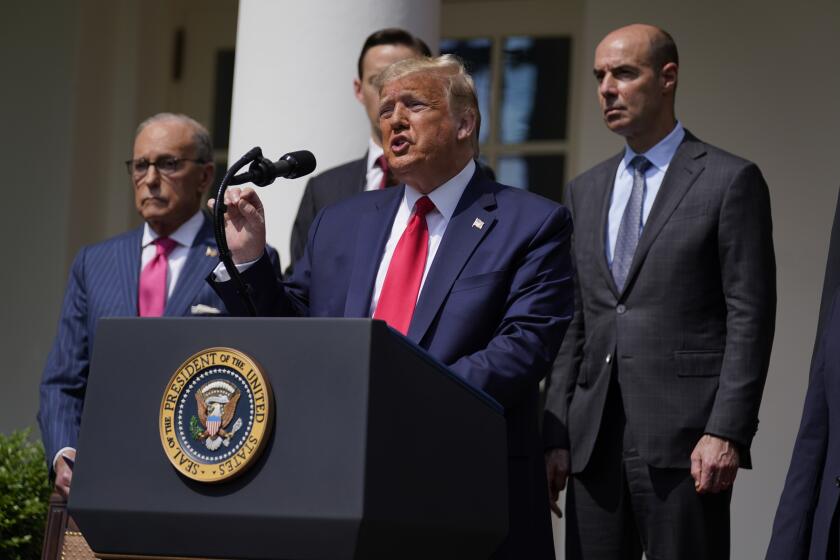Four consequences of a $15 minimum wage

Workers march through downtown Los Angeles on April 14 to demand a nationwide $15-an-hour minimum wage.
- Share via
Exhaustive research over the past few decades suggests raising the minimum wage has little negative impact on overall employment.
Problem is, most past wage hikes have been relatively modest, and there's no data to confidently predict what might happen following the kinds of increases now planned in California and New York.
Going to $15 an hour represents a 50% rise from California's current minimum pay of $10, and a 67% jump for New York.
Although these would be phased in over several years and would not apply statewide in the case of New York, the sheer size of the increases has made even proponents of higher minimum wages a little worried.
RELATED: Who wins with a $15 minimum wage?
It's a grand experiment with potentially profound consequences — some good, some bad — that could extend far beyond the borders of the nation's two largest states, with ramifications for the health and direction of the U.S. economy and society.
"The minimum wage debate hints at the very essence of who we are, how we function together and what we'll become," said Arthur Laffer, the well-known economist who served as an advisor to President Reagan.
Here's what some experts are expecting:
1. It may increase unemployment among minority youth.
Because teenagers and young adults hold a disproportionately large share of low-wage jobs, they figure to be among the hardest hit, pushed out by older and better-educated workers who will be drawn by the higher pay offered by retail stores, food services and other businesses.
That could hurt opportunities, especially for black teenagers, one of the most vulnerable groups in America. The unemployment rate for African Americans ages 16 to 19, while down by almost half from 2010, still stands at 25%. That compares to 13.9% for white youth and 15.6% for Latino youth.
RELATED: California minimum wage hike hits L.A. apparel industry: 'The exodus has begun'
If policymakers blame high crime in cities such as Chicago on steep poverty and unemployment, Laffer asked, should they still advocate for a high minimum wage that might reduce jobs for the youth and exacerbate social problems?
Another side effect of higher minimum wages may be that teenagers will be "induced to leave school, interrupting or prematurely ending their formal education," write researchers Dale Belman of Michigan State University and Paul Wolfson of Dartmouth's Tuck School of Business.
But they added that research findings about the impact on schooling and minority youth are not conclusive enough to be used by policymakers.
2. Wage disparity within states will shrink.
There is little doubt that the new minimum wage laws in California and New York will help reduce the increasing disparity in earnings between the highest and lowest paid workers in those states.
In California, the bottom 10% of wage earners made on average $9.48 an hour last year, a 20% increase since 2005, unadjusted for inflation. Workers in the top 10% of wages earned on average $53.08 an hour, a 35% jump from 2005, according to data from the Bureau of Labor Statistics.
The upshot is that the difference between the bottom and top 10% of wages in the state has widened over the past decade, to $43.60 an hour from $31.35. The trend is almost exactly the same for New York.
See the most-read stories this hour >>
With minimum wages set to rise steadily in the years to come, and during a period when inflation is forecast to stay historically low, low-wage workers "will achieve a much higher level than they ever have, and that will reverse decades in which wages have been stagnant or falling at the bottom of the distribution," said Michael Reich, chair of UC Berkeley's Institute for Research on Labor and Employment.
"It's going to provide people, not with security, but with fewer headaches," he said. "If their car breaks down, they might have money to repair it or buy a used car, which will help them get to work, to child care and so on."
And it should help children in the long run too, Reich said. "We know that higher income leads to better parenting, better mental health and better school outcomes."

3. The red-state, blue-state divide could get worse.
The dramatic differences in minimum wages soon to be paid across the country could worsen the income gap between rich and poor states.
It's a fissure that has generally narrowed over most of the past century, according to Andrew Gelman, a statistician at Columbia University and author of "Red State, Blue State, Rich State, Poor State."
It is generally the richer, Democratic-leaning states, including Maryland, Massachusetts, Washington and Oregon, that have pushed through higher minimum wages in recent years and are candidates to follow California and New York by adopting a statewide $15-an-hour floor.
Most of the 21 states with minimum wages equal to or less than the federal rate are in the so-called Red or Republican-leaning states in the South and the Great Plains.
This distinction matters not just for politics, but in their different approaches to regulation and the economy — differences that appear to be getting sharper with such policies like "super-minimum wage laws," as analysts at the conservative Heritage Foundation call the higher-wage laws.
There is a similar divide when it comes to which states have embraced President Obama's expansion of Medicaid for the poor, giving poor residents in Democratic-led states better access to health coverage than their counterparts in Republican-led states.
Richard Florida, an urban development expert at the University of Toronto, sees the $15-an-hour minimum wage push as an indication of the increasing polarization in America in which there are competing visions: one driven by people in large, dense metropolitan areas with a strong information economy, and the other by folks in rural regions more dependent on resources and real estate.
"We are being ever more sorted by class, by income, by education, by occupation and by political orientation," he said.
Join the conversation on Facebook >>
4. More low-paying jobs will go underground.
"A lot more are going to get hired off the books," especially immigrant workers, said Harry Holzer, a public policy professor at Georgetown University.
The Labor Department's top economist in the Clinton administration's second term, Holzer never imagined that the campaign for $15 an hour would actually succeed. He thought $15 was more of a bargaining ploy to get to $10 an hour, or maybe $12.
Now Holzer fears there will be heavy job losses, hurting most the low-skilled, less-educated workers who may have to accept cash under the table or cut deals to keep their jobs.
Informal work isn't necessarily illegal or bad. It includes jobs such as babysitting and housecleaning that provide much-needed side incomes or can introduce a young person to the world of work, Demetra Smith Nightingale and Stephen A. Wandner wrote in an Urban Institute paper.
Still, a rise in informal work translates into more tax avoidance and generally means fewer worker benefits and protections, like unemployment insurance.
As such, a higher minimum wage may backfire for some low-income workers unless there also are changes that encourage workers and employers to do things by the book.
Follow me on Twitter @dleelatimes
ALSO
Gannett offers to buy Tribune Publishing in $815-million deal
NBC is cutting the number of commercials during 'Saturday Night Live'
The Harriet Tubman $20 and other faces on money show how we want to remember history
Inside the business of entertainment
The Wide Shot brings you news, analysis and insights on everything from streaming wars to production — and what it all means for the future.
You may occasionally receive promotional content from the Los Angeles Times.








